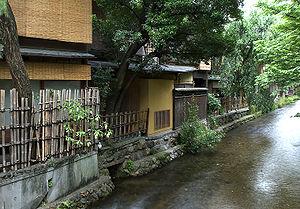
Higashiyama-ku, Kyoto
Encyclopedia

Wards of Kyoto
The city of Kyoto in Kyoto Prefecture, Japan has eleven wards.Unlike the 23 special wards of Tokyo, the wards of Kyoto are not separate municipalities, they are divisions just for municipal administration. Together, they comprise the city of Kyoto, under a single mayor and city council....
in the city
Municipalities of Japan
Japan has three levels of government: national, prefectural, and municipal. The nation is divided into 47 prefectures. Each prefecture consists of numerous municipalities. There are four types of municipalities in Japan: cities, towns, villages and special wards...
of Kyoto, in Kyoto Prefecture
Kyoto Prefecture
is a prefecture of Japan located in the Kansai region of the island of Honshu. The capital is the city of Kyoto.- History :Until the Meiji Restoration, the area of Kyoto prefecture was known as Yamashiro....
, Japan
Japan
Japan is an island nation in East Asia. Located in the Pacific Ocean, it lies to the east of the Sea of Japan, China, North Korea, South Korea and Russia, stretching from the Sea of Okhotsk in the north to the East China Sea and Taiwan in the south...
. It was created in 1929 when it was split off from Shimogyō-ku
Shimogyo-ku, Kyoto
is one of the eleven wards in the city of Kyoto, in Kyoto Prefecture, Japan. First established in 1879, it has been merged and split, and took on its present boundaries in 1955, with the establishment of a separate Minami-ku....
. During the years 1931 to 1976 it also covered the area of present-day Yamashina-ku
Yamashina-ku, Kyoto
is one of the eleven wards in the city of Kyoto, in Kyoto Prefecture, Japan. It lies in the southeastern part of the city, and Yamashina Station is one stop away from Kyoto Station on the Tōkaidō Main Line ....
, which was an independent town
Towns of Japan
A town is a local administrative unit in Japan. It is a local public body along with prefecture , city , and village...
until its merger into the city in 1931. The name literally means "Eastern Mountain District".
Interposed between the Kamo River
Kamo River
The is located in Kyoto Prefecture, Japan. The riverbanks are popular walking spots for residents and tourists. In summer, restaurants open balconies looking out to the river. There are pathways running alongside the river on which one can walk along the river, and some stepping stones that cross...
and the Higashiyama mountain range, Higashiyama-ku is roughly bounded by the Sanjō street in the north, and the Jūjō street in the south. Historically, this area lay outside the official boundaries of the city of Kyoto. The western part consists mainly of residential areas, whereas the eastern part is covered by forests. In the north, between the Kamo River and Higashi-oji street, there is a commercial district, and in the south there is a semi-industrial zone.
Many of the locations central to the development of 15th century Japanese culture known as Higashiyama Bunka are found here or in Sakyō-ku
Sakyo-ku, Kyoto
is one of the eleven wards in the city of Kyoto, in Kyoto Prefecture, Japan. It was created in 1929 when it was split off from Kamigyo-ku.It is located in the north-east corner of Kyoto city. In the east it borders the city of Ōtsu in Shiga Prefecture. In the south Sanjō Street separates it from...
. Both the entertainment district of Gion
Gion
is a district of Kyoto, Japan, originally developed in the Middle Ages, in front of Yasaka Shrine. The district was built to accommodate the needs of travelers and visitors to the shrine...
in front of Yasaka Shrine
Yasaka Shrine
', once called , is a Shinto shrine in the Gion District of Kyoto, Japan. Situated at the east end of Shijō-dōri , the shrine includes several buildings, including gates, a main hall and a stage.-History:...
, and the area around the stone-paved roads Ninenzaka and Sannenzaka that lead up to the World Heritage Kiyomizu Temple, enjoy protected status to preserve the traditional style buildings. Other temples and shrines in the ward include Tōfuku-ji
Tofuku-ji
is a Buddhist temple in Higashiyama-ku in Kyoto, Japan. Tōfuku-ji takes its name from two temples in Nara, Tōdai-ji and Kōfuku-ji. It is one of the so-called Kyoto Gozan or "five great Zen temples of Kyoto". Its honorary sangō prefix is .-History:...
, Kennin-ji
Kennin-ji
, is a historic Zen Buddhist temple in Higashiyama, Kyoto, Japan, near Gion. It is considered to be one of the so-called Kyoto Gozan or "five most important Zen temples of Kyoto".-History:...
, Kōdai-ji
Kodai-ji
, formally identified as , is a temple of the Rinzai school of Zen Buddhism in Higashiyama-ku, Kyoto, Japan—the largest subtemple of the Kennin-ji branch. It was established in 1606 by Nene , the widow of Toyotomi Hideyoshi, to pray for her late husband...
, and Sanjūsangen-dō
Sanjusangen-do
is a Buddhist temple in Higashiyama District of Kyoto, Japan. Officially known as "Rengeō-in" , or Hall of the Lotus King, Sanjūsangen-dō belongs to and is run by the Myoho-in temple, a part of the Tendai school of Buddhism. The temple name literally means Hall with thirty three spaces between...
. The Kyoto National Museum
Kyoto National Museum
The is one of the three formerly imperially-mandated art museums in Japan. The museum is located in Higashiyama Ward in Kyoto. The collections of the Kyoto National Museum focus on pre-modern Japanese and Asian art....
is also located inside Higashiyama-ku.
Due to the restrictions against urban development, the population inside the ward is continually decreasing. Higashiyama-ku has the lowest population of all the wards in Kyoto, and a disproportionate number of elderly people.

